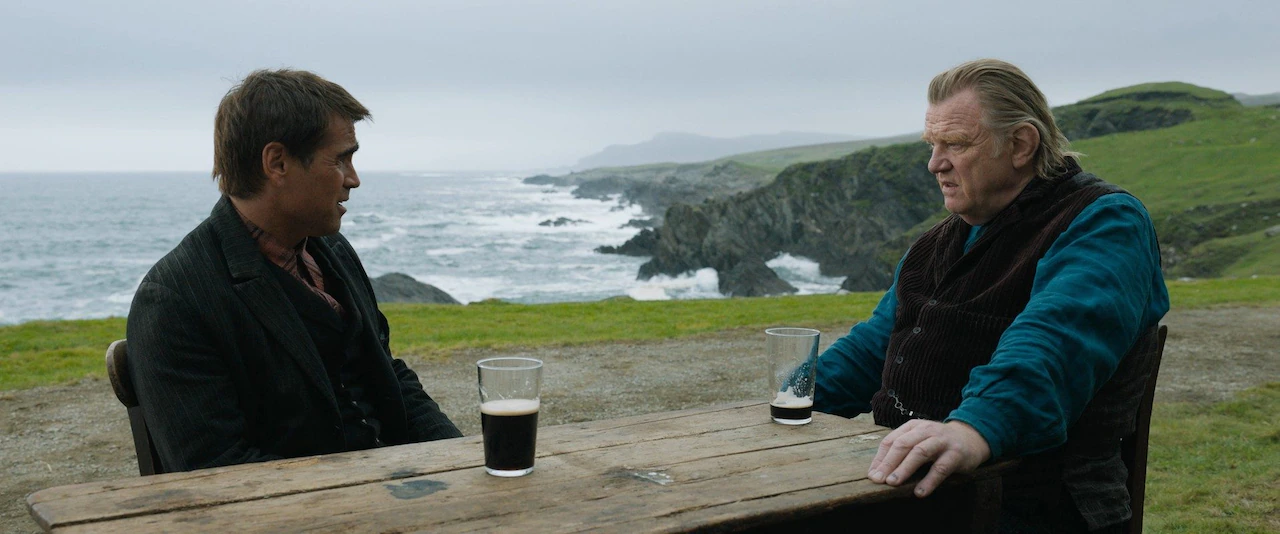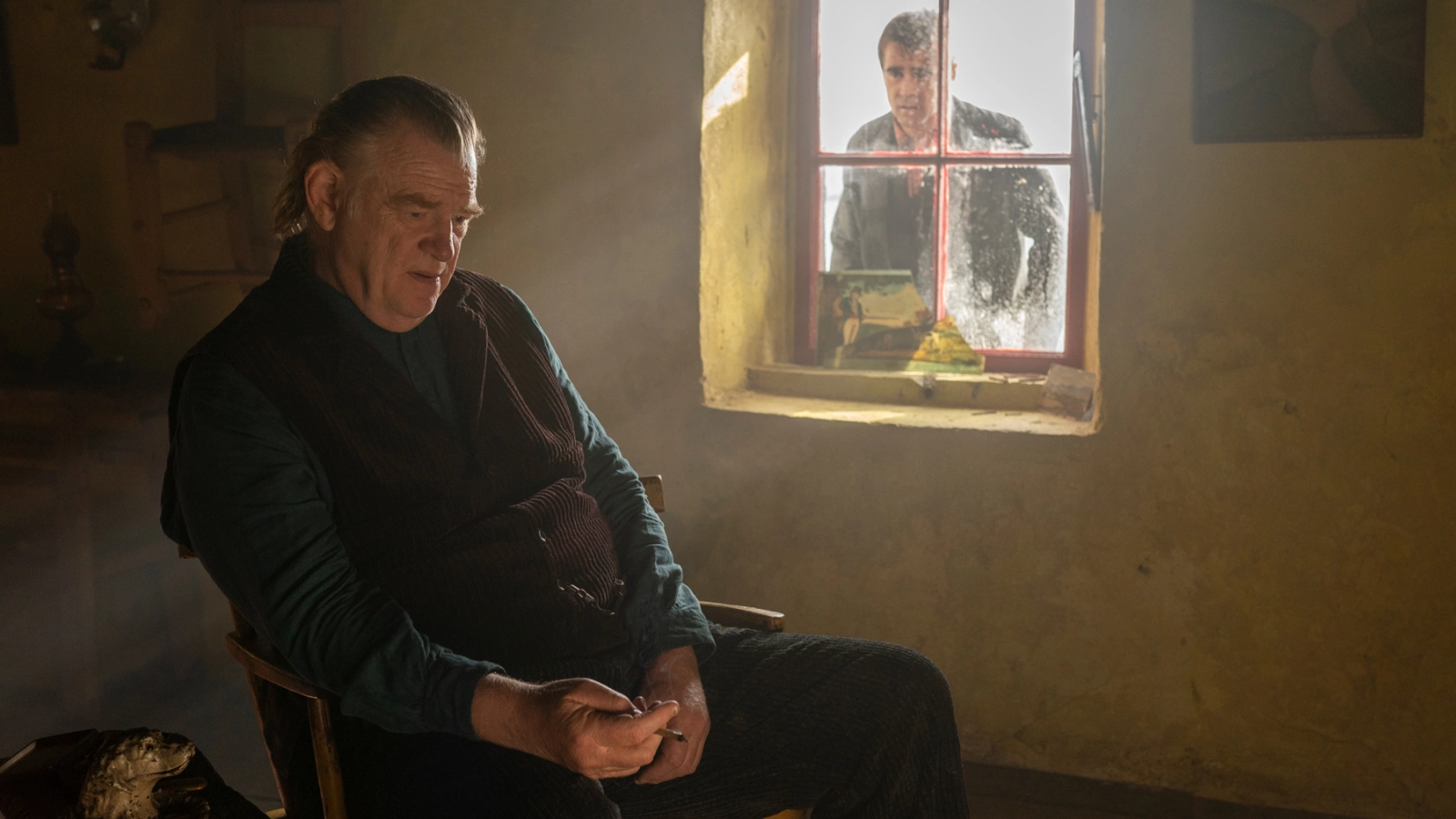Movie Review: "The Banshees of Inisherin"
Writer-director Martin McDonagh reunites his 'In Bruges' duo and turns a buddy tragedy into a masterpiece. A magnificent look at the end of a friendship and the beginning of a war.

The island of Inisherin, a rustic windswept rock off the coast of Ireland, does not appear on any real-world maps, but its geography is unmistakable. Not only because of the jumpers and the sheep, the pints of Guinness and the thatched roofs bespeak a carefully curated Irish authenticity, but also because what happens on this island locates it firmly in an imaginary region that might be called County McDonagh. This being a McDonagh work, it’s a comedy of mortification as well as exasperation. It begins with a beautiful overhead shot of the title Irish island, all green below a clear blue sky (in this picture it only rains at night, which, considering actual weather patterns in Ireland, places the film in yet another genre, that of fantasy)
“I just don’t like ya no more.”
In terms of sentences that have kickstarted wars and caused bloodshed, this simple utterance is pretty tame. It is still world-shaking, however, to the Irish man hearing it, especially as it's coming from the mouth of his best friend in the world. Every day, Pádraic Súilleabháin (Colin Farrell) walks down the unpaved road that runs along the edge of his village on the island of Inisherin, past the stone walls and statue of the blessed virgin, to the house of Colm Doherty (Brendan Gleeson). Then they go over to the local pub and, pints in hand, waste the afternoon away with small talk and song. It’s been this way since Pádraic can remember. It’s the way things will be until the end of time. Then, one day, Pádraic leaves the modest house he shares with his sister, Siobhan (Kerry Condon), his cow herd, and Jenny the miniature pet donkey, and goes to fetch his drinking companion. There’s no answer to his knock. He spies Colm through the window, sitting alone, smoking. Confused, the man ambles down to the tavern by himself. “Have you been rowin’?” asks the bartender. “I don’t think we’ve been rowin’,” Pádraic replies. When he finally catches up to Colm at the bar, his pal tells him to sit elsewhere. What’s going on, the younger man wants to know. And then Colm says the seven words that will cost these two gents a lot more than just their friendship.

Nobody does self-loathing like the Irish, and with this film, McDonagh is on much surer footing than he was when trying to tell America a thing or two with his film “Three Billboards Outside Ebbing, Missouri” in 2017. “The Banshees” has touches of tenderness that are sometimes ever-so-slightly confounding, as when Colm shows care for Pádraic after the latter gets a pasting from Dominic’s bastard cop father. Being the writer he is, McDonagh often counters those tender moments with bracing reality checks. And as a director, he orchestrates the give-and-take between Farrell and Gleeson with the mastery of someone who appreciates these performers as much as discerning audiences do.
As for the rest of the cast, they are a note-perfect ensemble, a flawless instrument upon which McDonagh plays his deliciously melancholy dance. Farrell does some of his best acting with his furrowed eyebrows; Gleeson has a glare that’s both a death ray and an enigma. The pauses these men enact are at times even funnier than the verbal comebacks McDonagh has come up with for them. And as it happens, Barry Keoghan as Dominic almost steals the movie out from under the leads, his very funny vulgar brashness never quite camouflaging his character’s poignant vulnerability.
There’s such an incredible give and take between the two leads, and while we’ve been taking Gleeson’s off-kilter charisma for granted since 1998’s “The General”, the performance that leaves scars is Farrell’s. It’s tough to think of a portrayal that finds so many emotional shades and levels of depth in incomprehension; his Pádraic can’t grasp the logic behind his friend’s decision any more than he can control his reactions, his sudden neediness or the shame that he’s done something wrong by doing nothing much with his life. You also see why a friend might be tempted to back away from him as well, yet you never feel that Farrell is tipping his hand toward sympathy or antipathy for this remarkably simple soul. It’s not a coincidence that the two men give the film’s ending a sense of ambiguity regarding what might happen after the credits' role. Yet it’s also not a mistake that Farrell is the one who gets the final shot, and that he’s the one who leaves you with the sense that you’ve just witnessed wounds that may never heal.

Both a comedy and a tragedy — one that substitutes Irish wit and irony for the Greeks’ gods and monsters – the film somehow feels ancient; it takes place in 1923, not coincidentally when Ireland was embroiled in its own Civil War, yet you’d swear that it was adapted from a fable scribbled a century ago. If you only know writer-director Martin McDonagh from his films, like the Beckett-with-bullets buddy comedy “In Bruges” (2008) or the curiously divisive “Three Billboards Outside Ebbing, Missouri” (2017), you might find this more subdued than his usual concoctions of pulp-fiction archetypes with a penchant for poetic profanity. Fans of the former will still be jazzed to see Farrell and Gleeson doing their double act again, of course, and there’s enough gloriously warped verbiage to scratch that bad-mouth-fast-talk itch. You won’t believe how lyrical the colloquialism “feck” can be, regardless of whether it’s used as a noun, a verb, an adjective, a sign of affection or a salty exclamation. McDonagh also wants to give his actors a hell of a showcase, too, and it’s the two stars butting brows at the centre of “The Banshees of Inisherin” that make this a masterpiece of men behaving very feckin’ badly. We don’t want to ignore the exquisite cinematography by Ben Davis, or Carter Burwell’s ability to channel both regional folk music and a universal sense of grief in his score. Visually, cinematographer Ben Davis and production designer Mark Tildesley create painterly interiors that recall the canvases of Vermeer and the compositions of Danish director Carl Theodor Dreyer. At the same time, composer Carter Burwell emphasises the film’s fable-like qualities with refrains that sound like off-kilter nursery rhymes played on cracked shellac records. It’s just that the Farrell-Gleeson Blues Explosion is what grounds McDonagh’s heady notions and fuels its fire.
Overall, “The Banshees of Inisherin” might feel a little thin if you hold it to conventional standards of comedy or drama. It’s better thought of as a piece of village gossip, given a bit of literary polish and a handsome pastoral finish. Inisherin may not be a real place, but its eccentric characters, rugged vistas and vivid local legends make it an attractive tourist destination.